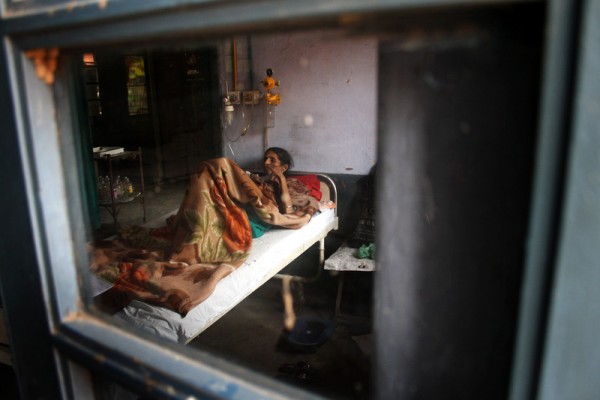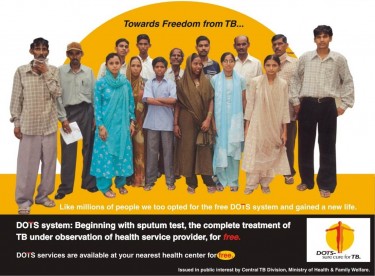24th March is observed as World Tuberculosis Day and this year, the various stakeholders dedicated to fight tuberculosis – government agencies, the medical community, NGOs and health activists, took time out to take stock of how India was faring in it's fight against the dreaded disease.
With nearly 2.2 million cases each year, India has the highest burden of TB in the world and despite all efforts, the instances of drug-resistant TB is on the rise. On the occasion of World Tuberculosis Day, the President of India, Mr. Pranab Mukherjee, re-emphasized the country's commitment towards achieving “zero TB deaths”. Acknowledging that the challenge ahead remained a difficult one, he said [pdf]:
On the occasion of World Tuberculosis Day, I commend the important work that has been undertaken by various stakeholders led by the National TB Programme. Since 1998, due to the successful implementation of the DOTS strategy; more than 14.2 million people across India have accessed treatment.
However, it is worrisome that India continues to have the highest burden of TB in the world. One of the greatest challenges facing TB control is the detection and management of drug resistant strains of TB. Such challenges highlight the need for strengthening research and development to urgently introduce new diagnostics, drugs and vaccines.
In its fight to tackle the growing public health threat, the government of India has, in 2012, made two important policy decisions. In a recent email, Kritika Kamthan, program associate at Global Health Strategies (GHS), explained what these policies were about and how they appeared to be faring on the ground. She wrote:
More than half of all TB patients are managed in the private sector in India, where, the quality of care is highly variable, there is rampant use of inappropriate diagnostics and also well documented are examples of over-treatment and the use of irrational drug regimens. The Government of India has recently made two significant policy decisions:
- Making TB a notified disease: On May 7, 2012 the Government of India (GoI) declared TB a notified disease. The announcement [pdf] signifies that with immediate effect all private healthcare providers, caregivers and clinics treating a patient suffering from TB will have to report every single case of TB to local authorities – district health officer/chief medical officer of a district and municipal health officer of a municipal corporation, every month. However, the policy does not guarantee medical confidentiality of TB patients. As a result of the stigma associated with TB, it is likely that most of these patients might be forced to go underground and refrain from accessing the healthcare system.
- Banning blood tests/serology based tests for TB diagnosis: On June 7, 2012, the GoI banned the manufacture, sale, distribution, use and import of serology based kits for diagnosis of TB. However, these tests are still being widely misused by the private sector despite not being recommended by the RNTCP or any agency.
Despite the recent policy changes, there has been a rise in morbidity, mortality, development of drug-resistance, and an increasing economic burden which is severely hampering India’s ability to prevent and control TB.
Kritika recognized the role played by the media in building awareness and highlighting the issues surrounding the disease. However, she was also quick to point out that much more could be done in this area especially in the digital space. According to her:
The Indian TB landscape has undergone a drastic change since last year. The discussions around the various challenges including the rise of drug resistant TB, TB/HIV co infection, lack of timely and correct diagnosis, over the counter sale of anti-TB drugs and stigma, have been extensively covered in the media. [However] keeping in mind that nearly 1000 people in India succumb to TB every day, the urgency of the situation needs to be given more prominence in the online space as well.

A TB patient under treatment at TB hospital in Amritsar, India. Image by Sanjeev Syal. Copyright Demotix (23/3/2013)
In a guest post on the Science Speaks Blog, Dr. Madhukar Pai, an associate professor of epidemiology at McGill University, Montreal, mentioned that India's fight against TB is at a “critical juncture” and that innovative approaches would be required in order to achieve control and eradication. India's Ministry of Health too, has recognized this and has tried to mark a paradigm shift in the way TB is detected and treated in the country.
On his blog, Healthcare in India, Dr. Vikram Venkateswaran rues the fact that TB has “fallen off the radar of the empowered Indian”, possibly because a) it affects the lower strata of society much more and b) there continues to be social stigma associated with the illness. He points out that
the fight against TB has to be fought on two fronts- Medical front and on the Societal front. On the medical front our doctors and health workers are in action, but it is upto us to Galvanise the society and do what is needed.
India has an ambitious aim. As President Mukherjee pointed out, “India’s vision is to provide ‘Universal Access to Quality Diagnosis and Treatment’ over the next five years to all, regardless of their economic or social status.” In the past, India has successfully combated other public health threats such as polio and small pox. It remains to be seen, how the fight against TB progresses. After all, this is one fight that India cannot afford to lose.







